As California’s housing market dives deeper into the recession in 2023, it’s important to note that Orange County’s housing market never fully recovered from the 2008 recession. Home sales volume remained low throughout the elongated recovery of the 2010’s, as did job creation. Residential construction of all types continues to struggle in this region, leaving would-be homebuyers wanting for more and helping push prices into bubble territory over the past decade.
The Pandemic Economy of 2020-2021 briefly distorted sales, inflating both sales volume and prices. However, as the effects of pandemic stimulus are now behind us and mortgage rates skyrocketed in 2022, homebuyers have backed off from acquisitions. Expect to see sales volume continue to plummet compared to pre-recession numbers, interrupted by a brief seasonal bump during the spring buying season.
The second act to the 2020 recession has now arrived, causing devastating waves in the housing market. This has included depressed sales volume, prices and inventory for sale. Watch for a return of real estate speculators in 2025 to provide a “dead cat” bounce during the sales slump, with a sustainable recovery taking off with the return of end user homebuyers around 2026-2027.
View the Orange County regional charts below for details on current activity and forecasts for its local housing market.
Updated August 6, 2023. Original copy posted March 2013.
Home sales volume dips
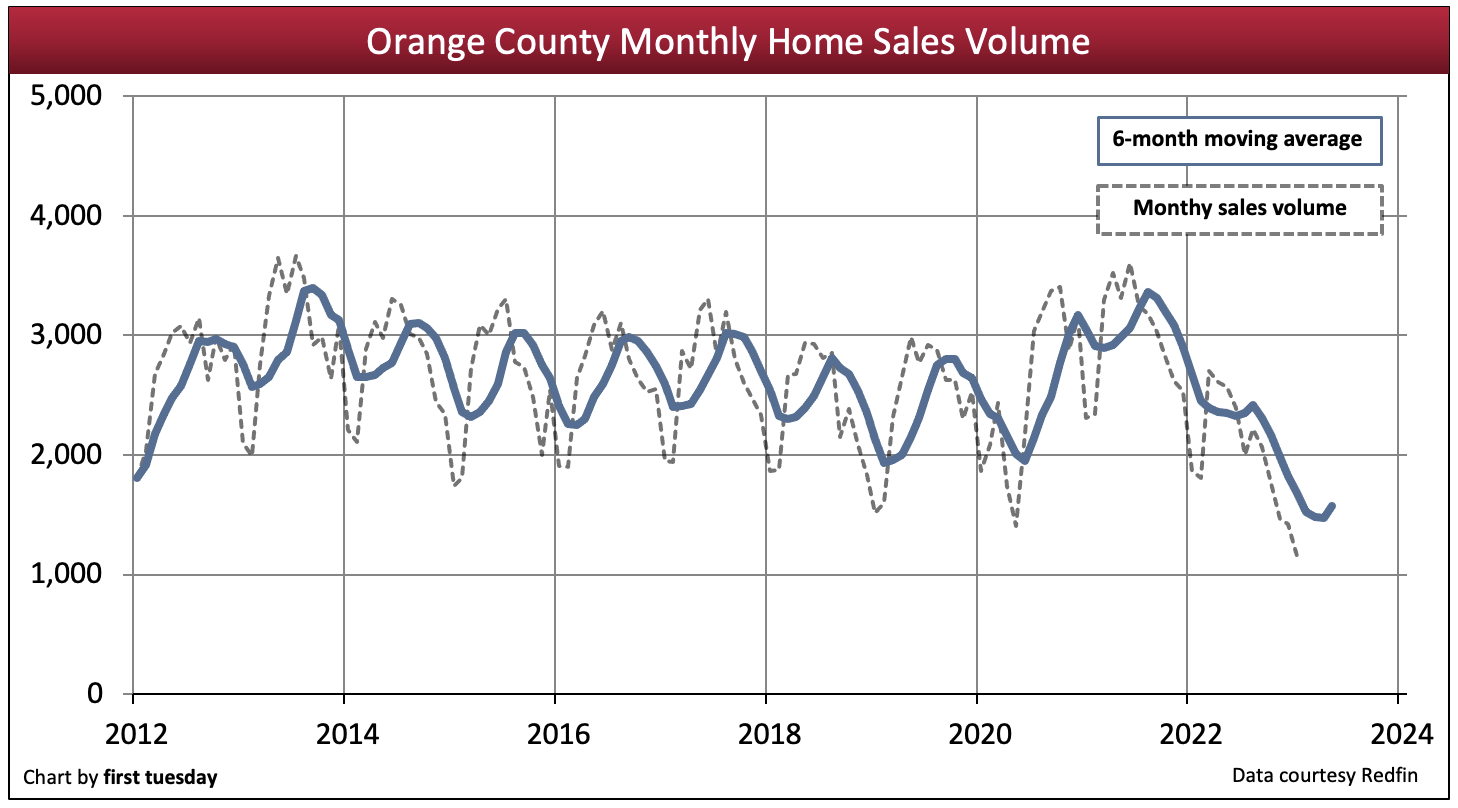
Chart update 08/06/23
| 2022 | 2021 | 2019 | 2003: Peak Year | |
| Orange County home sales volume | 24,900 | 35,800 | 29,700 | 53,900 |
Home sales volume in Orange County remains weak and somewhat stuck at just over half the heights seen during the Millennium Boom. Echoing state trends, Orange County saw a decrease in total home sales volume in 2018, ending the year 9% lower than in 2017. In 2019, home sales volume was a further 3% below 2018. But in 2020, home sales volume began to reverse course, and 2021 ended a significant 17% above a year earlier.
But the rising action of the past two years is at an end, as sales volume crashed in 2022. In total, 31% fewer sales closed escrow in Orange County during 2022 compared to 2021, and 16% fewer sales closed than during 2019 (the last “normal” year for sales volume). Year-to-date, 2023 sales volume is 31% below the prior year and a whopping 46% below 2019 as of May 2023.
For some historical context, 2009-2010 Orange County sales volume rose slightly with the introduction of the housing tax credit, falling back in 2011 for lack of end user demand. From the latter half of 2012 through most of 2013, speculator hyper-activity bumped sales volume artificially yet again, as it did in all of California. The speculator buying wave receded and sales volume slumped in 2016-2019.
Looking forward, expect a similar dynamic in the years that follow the 2023 recession. In 2020-2021, federal stimulus, Federal Reserve-induced low interest rates and the eviction and foreclosure moratorium provided a temporary boost to the housing market. Thus, the housing market continued its progress despite the economic recession. But as the government has now fully removed its support, will housing be able to stand on its own, in an organic recovery?
No. A complete recovery with annual sales volume of around 46,000 in Orange County will be reached only after end user demand is buttressed by labor force participation and normalized job levels, expected in the 2025+ recovery period from the 2023 recession.
Related article:
The Fed bumps up rates again — the undeclared recession is here
Inventory climbs
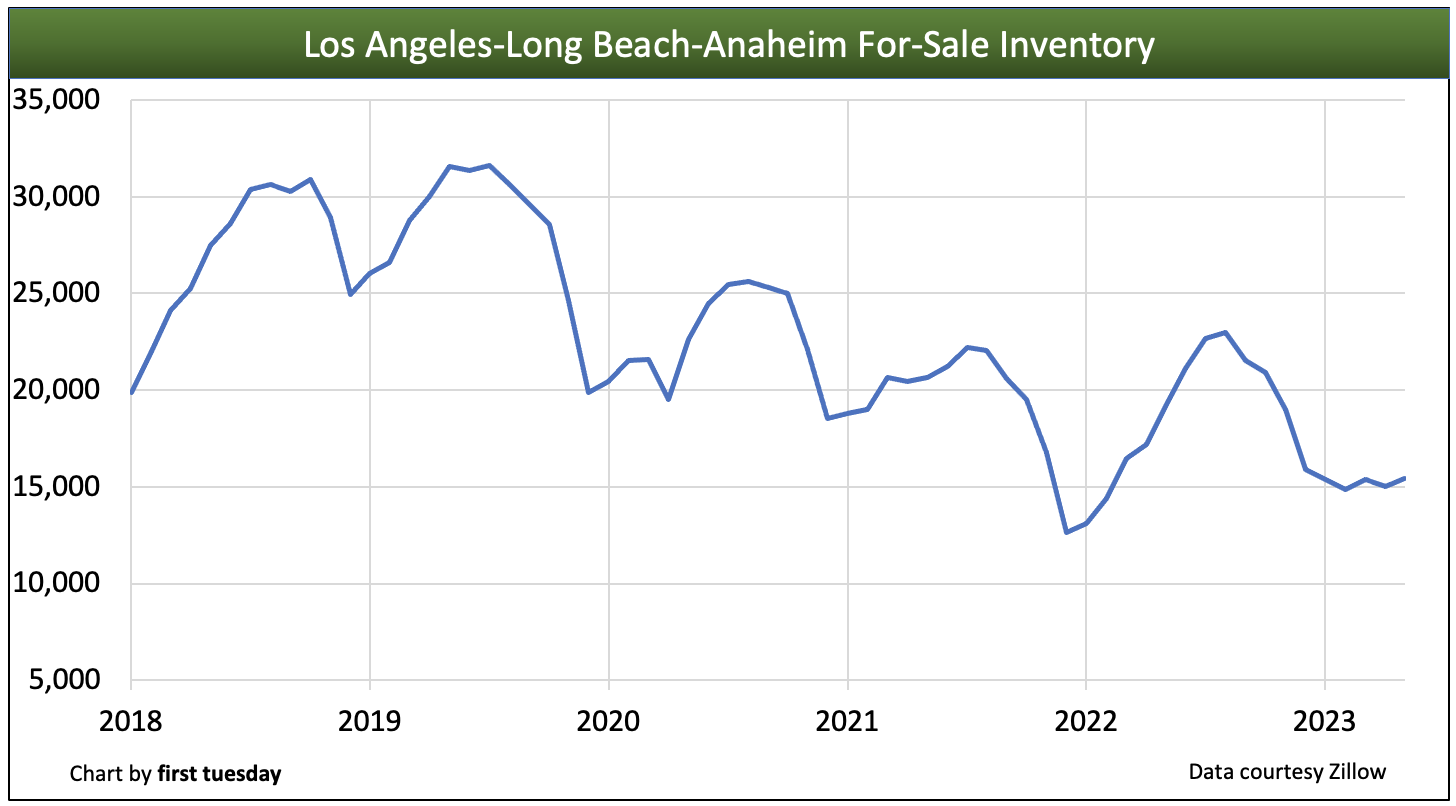
Chart update 08/06/23
| May 2023 | May 2022 | Annual change | |
| LA-OC County for-sale inventory | 15,400 | 19,200 | -20% |
Multiple listing service (MLS) inventory has risen from the historic low reached at the end of 2021. After two years of steep decline, for-sale inventory in the Los Angeles-Orange County metro area bounced slightly in 2022, now falling back to a 20% decline from a year earlier as of May 2023. The winter months typically see the lowest inventory of homes for sale, peaking around mid-year.
Looking forward, expect inventory to climb in 2024. The significant interest rate increases of 2022 slashed buyer purchasing power, making it nigh on impossible for mortgaged homebuyers to compete. Along with high inflation, the signs are pointing to an ongoing downturn in the housing market (absent a brief spring seasonal bounce for home prices) — of which homebuyers and sellers are well aware. Today’s sellers are increasingly reluctant to list while prices are dropping and rates are rising, resulting in an anemic inventory of homes for sale.
Low turnover rate to continue
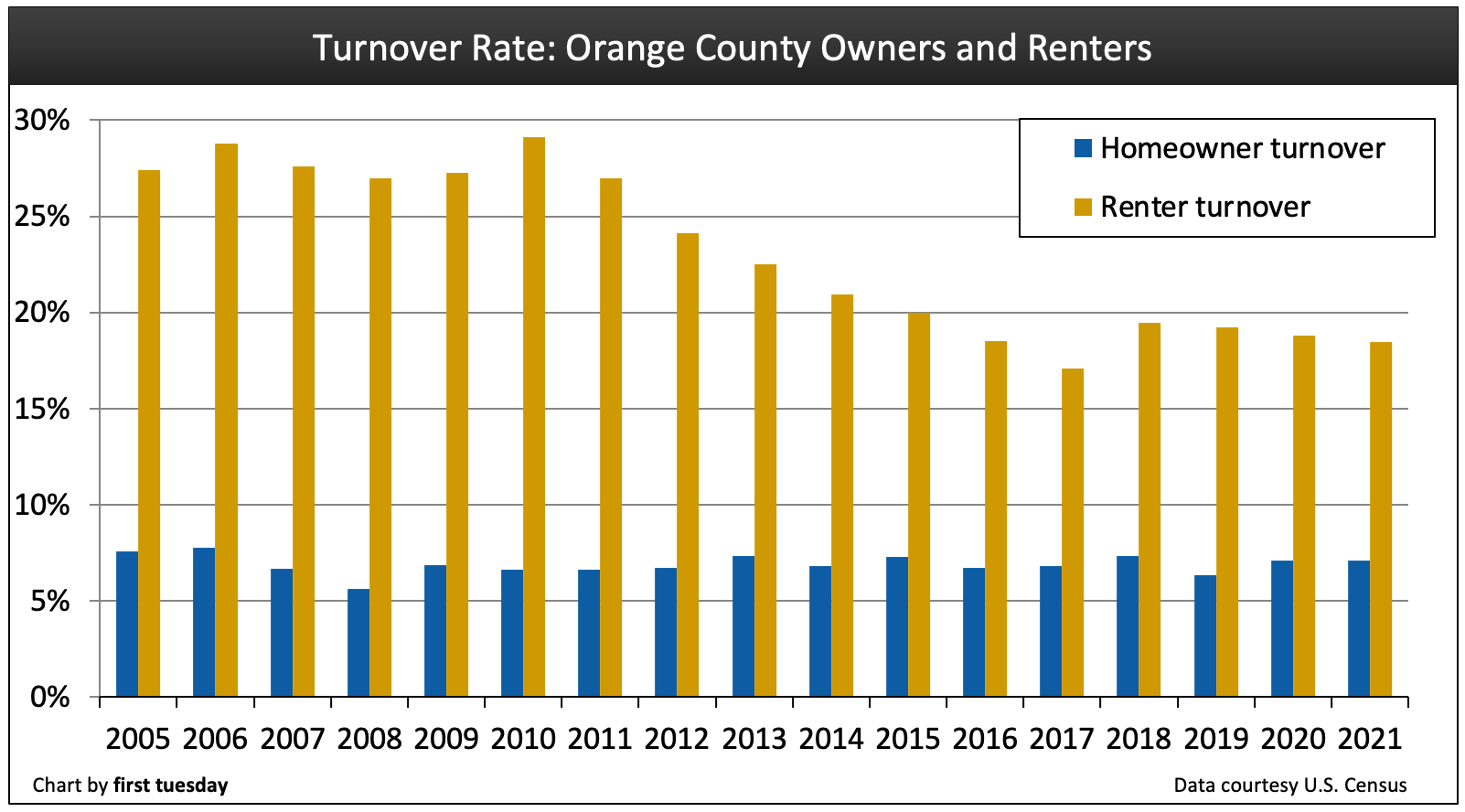
Chart update 11/07/22
| 2021 | 2020 | 2019 | |
| Orange County homeowner turnover rate | 7.1% | 7.1% | 6.3% |
Orange County renter turnover rate | 18.5% | 18.8% | 19.2% |
Without turnover, homes do not sell. The homeowner turnover rate in Orange County has remained mostly level since the end of the recession in 2009, at 7.1% as of 2021. The renter turnover rate has generally declined since 2010 and was at 18.5% in 2021, the most recently reported Census year.
Despite the rapid sales volume and price bumps in 2020-2021, 2020 recession job losses alongside COVID-19 eviction moratoriums meant significantly fewer renters and homeowners changed residences.
The homeowner turnover rate will rise once home prices and interest rates align to produce desirable homebuying conditions. This is not expected before 2025-2026, when the additional and necessary factor of greatly increased residential construction will be experienced and a sustainable and predictable recovery from the 2023 recession will begin. Then, members of Generation Y (Gen Y) will collectively rush to buy and Baby Boomers (Boomers) will retire en masse, selling and mostly buying replacement homes. International and domestic emigration into California will also play a significant role in suburban housing demand.
Homeownership remains low
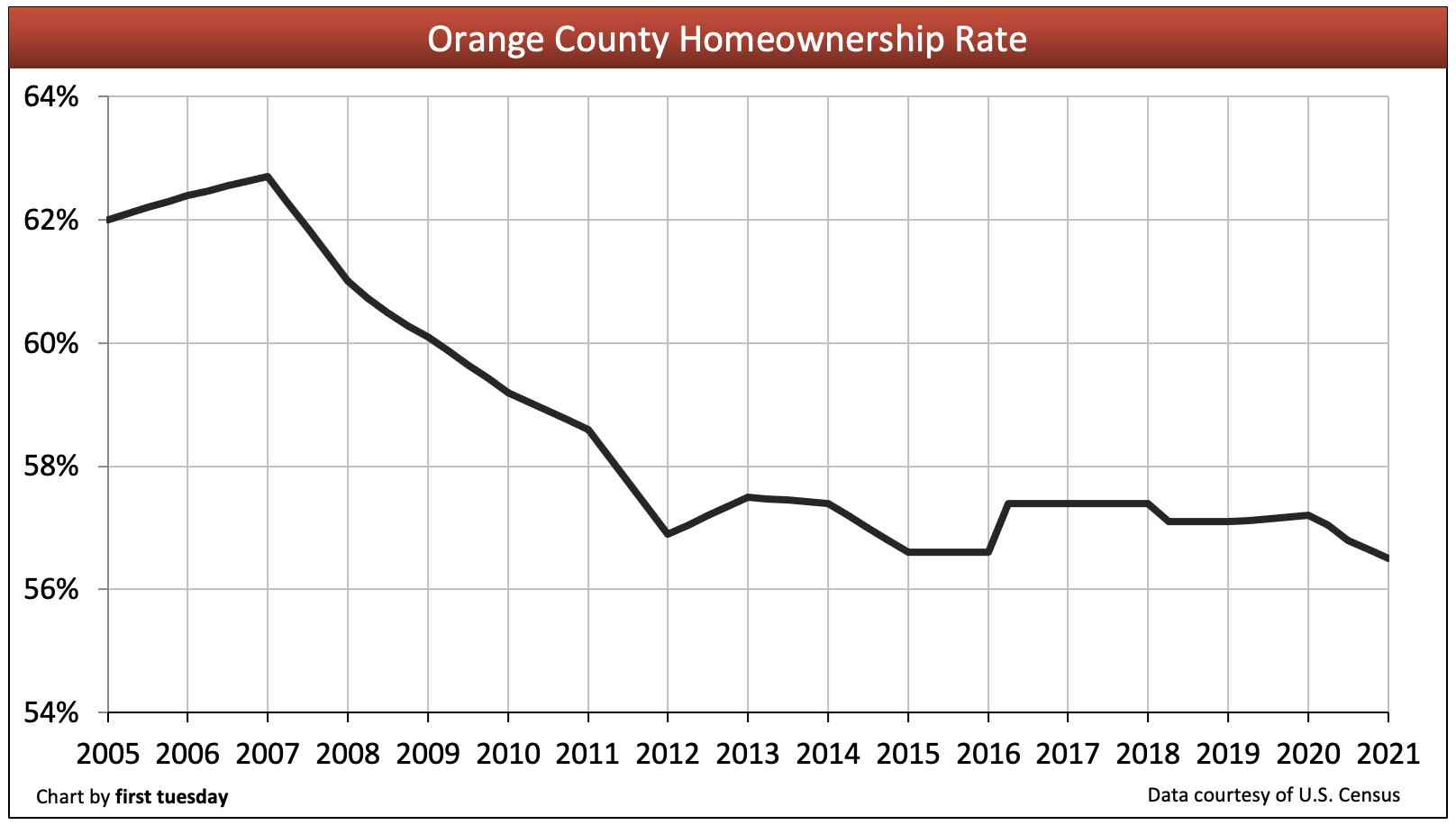
Chart update 11/07/22
| 2021 | 2020 | 2019 | |
| Orange County homeownership | 56.5% | 57.2% | 57.1% |
Orange County’s homeownership rate has fallen since its 2007 peak of 62.7%. The most recent homeownership data shows a 56.5% homeownership rate in Orange County. Statewide homeownership has historically been about two percentage points below Orange County’s. The state average is currently 55.7%, thus homeownership reports in Orange County in 2022 likely remain around 57%-58%.
Expect Orange County’s homeownership rate to remain near its present low level until around 2026, when the housing market will begin to bounce back from the 2023 recession. Only with the return of jobs, higher wages and increased confidence will the first-time homebuyer population gain traction.
However, don’t expect the rate of homeownership to fully return to the inflated heights seen in 2007 anytime soon. This rate was elevated by unfettered access to easy money, which mortgage regulators tamped down in 2014 with enforcement of ability-to-pay (ATR) rules to protect society from certain destabilizing types of mortgage lending. These rules limit mortgage funding to those homebuyers with the financial ability to actually repay their debts.
Thus, the housing market won’t see a repeat of those Millennium Boom homebuyers who lacked the proper finances. Though this translates to a slightly lower homeownership rate in the near term, it fosters a more stable future housing market in Orange County and the state. The shift of Gen Y to rentals for a longer period before buying a home than in past generations also puts a cap on home sales volume.
Construction starts fall back due to shortages
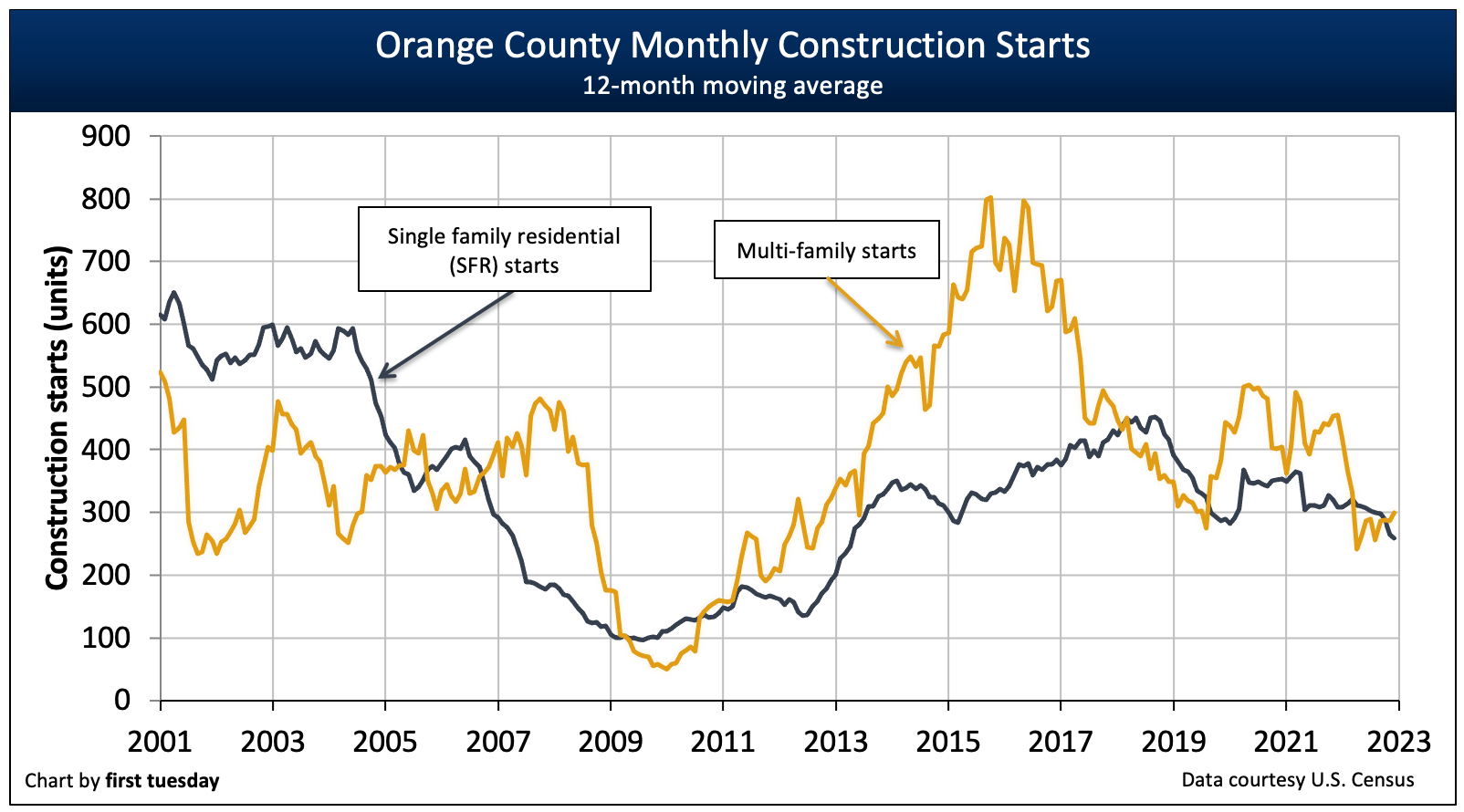
Chart update 02/13/23
| 2022 | 2021 | 2020 | |
| Orange County single family residential (SFR) starts | 2,900 | 3,500 | 4,000 |
Orange County multi-family starts | 3,100 | 4,900 | 3,600 |
After years of increased single family residential (SFR) construction starts, both SFR construction and multi-family construction have fallen consistently since 2018, with a temporary bump during 2021 in multi-family starts.
Multi-family starts in Orange County totaled 3,100 in 2021, down 36% from the previous year. SFR starts were down 17% in 2022. This general decline resumes a long downward trend in this populous region. However, statewide legislative moves focused on adding more housing for the ever-growing resident population will see multi-family gradually climb in the coming years.
Today’s slowing construction starts are partly the result of decreased confidence in the economy from lenders and builders, but are also a reflection of the building supply and labor shortages which have plagued the construction industry everywhere.
The next peak in multi-family construction starts will likely occur in 2024-2025 period due to a boost from state legislation. However, don’t expect SFR construction to recover fully anytime soon. The next peak in SFR construction starts will likely occur in the post-2024 era as renters shift to becoming homeowners following a statewide-push for more construction. Even then, SFR starts are unlikely to return to the mortgage-driven numbers seen during the hyperactive Millennium Boom.
Jobs are recovering, too slowly
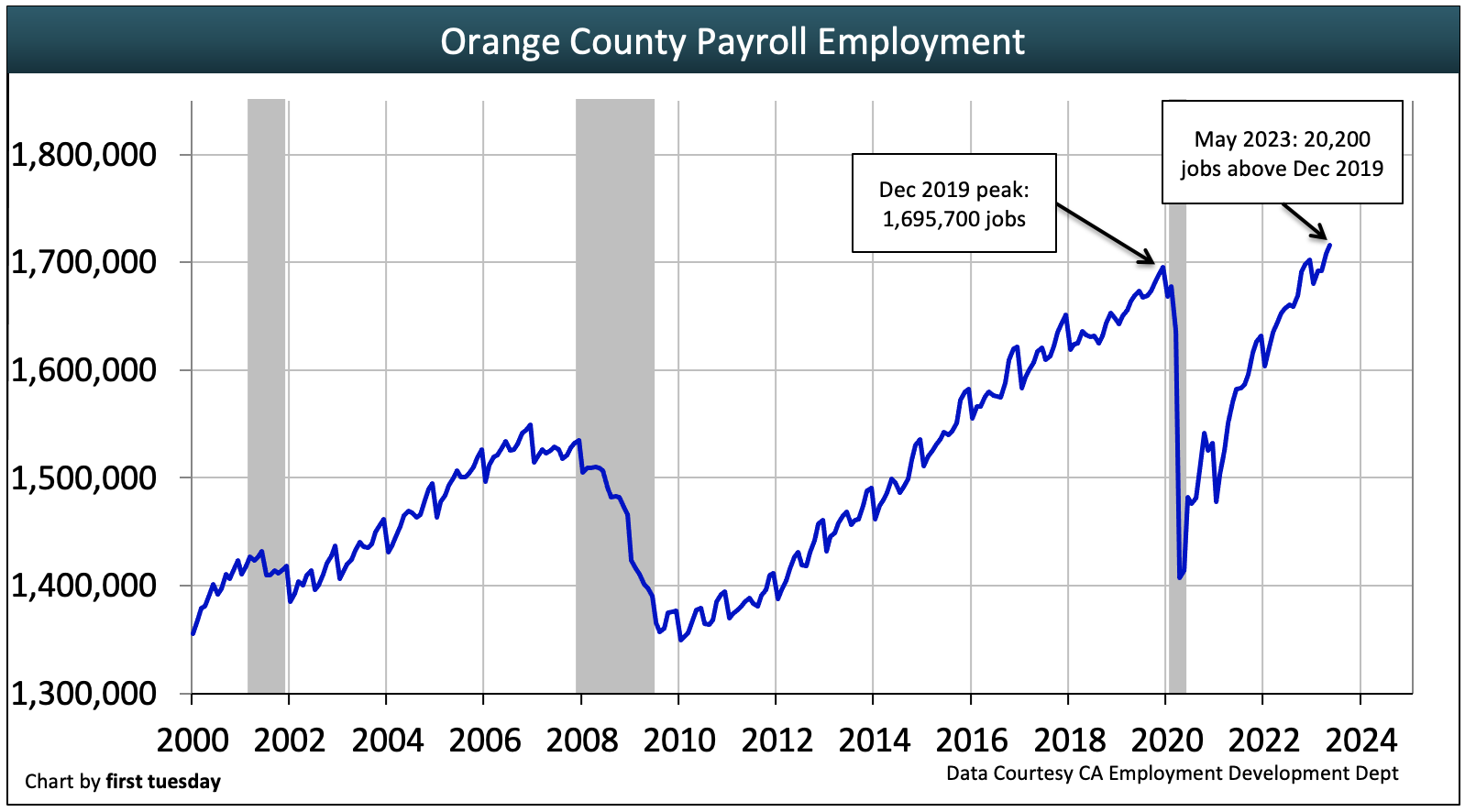
Chart update 02/13/23
| Dec 2022 | Dec 2021 | annual change | |
| Orange County jobs | 1,715,900 | 1,652,700 | +3.8% |
Orange County has finally recovered the historic job losses of 2020. While the number of jobs is still growing, at 3.8% above a year earlier in May 2023, the recovery pace is faltering. Now, compared to the pre-recession peak, Orange County is a slight 20,200 jobs above the number of jobs held prior to the 2020 recession.
Orange County was on course to return to pre-recession levels in 2020, but not before the 2020 recession arrived, causing significant job losses in the region. Expect a W-shaped recovery/recession in the coming months, with jobs continuing to recover in starts and stops, not to enter a true recovery until after the double-dip recession — which is still undeclared in 2023 — is behind us.
Jobs in the real estate industry
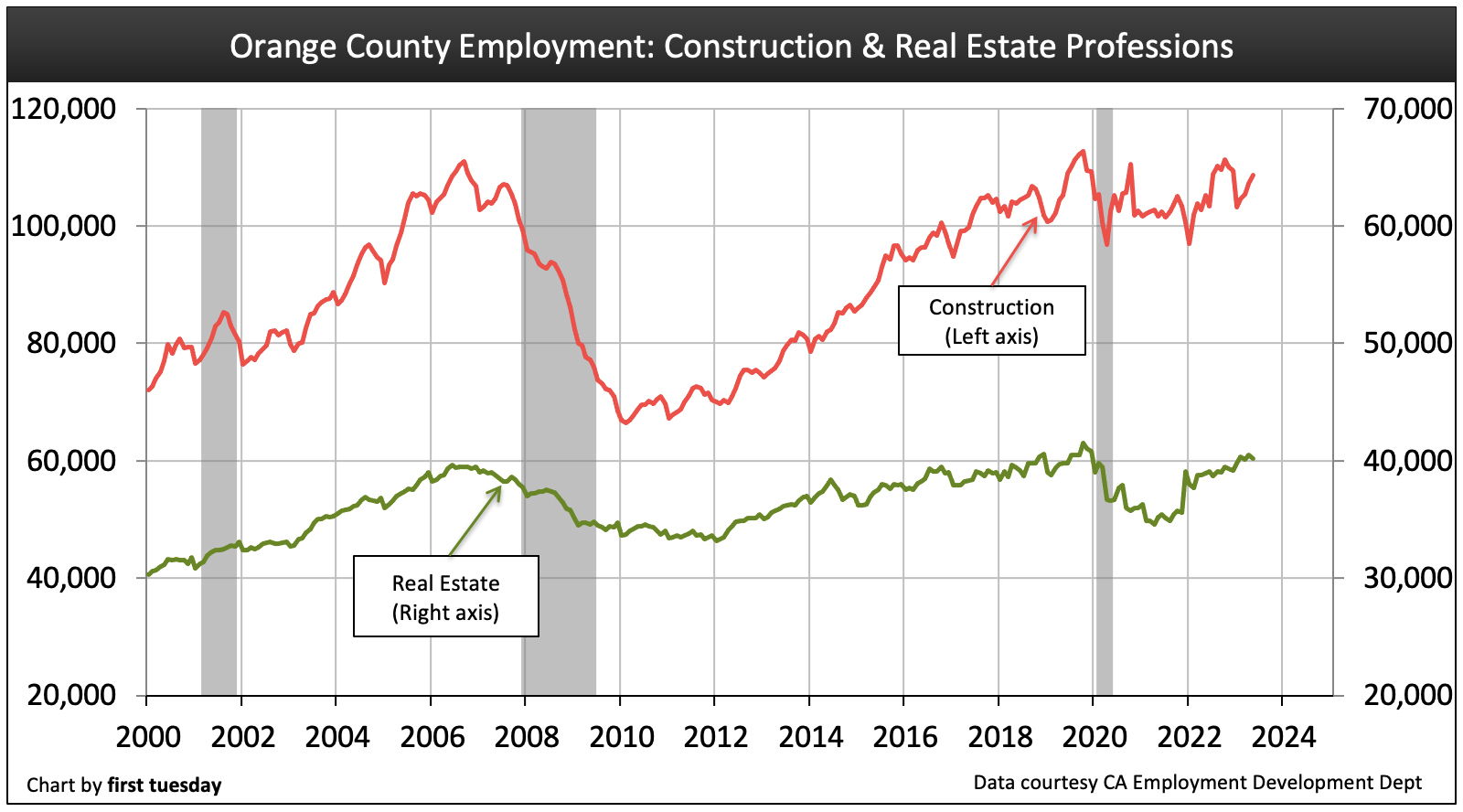
Chart update 08/06/23
| May 2023 | May 2022 | annual change | |
Construction | 108,600 | 105,200 | +3.2% |
Real Estate | 40,200 | 38,900 | +3.3% |
2020 job losses have nearly been recovered in California’s real estate and construction industries. The number of individuals employed in both the real estate and construction industries has increased 3% in the past 12 months. However, watch for these employment figures to fall back heading into 2024 as the housing market recession continues to make its mark on home sales and prices in the region.
Over the long term, Construction jobs will likely rise in the coming years, as state legislation focusing on adding more housing inventory is not impacted by the recession. The real estate industry will see jobs increase beginning around 2025 with the housing market’s recovery from the coming recession.
Per capita income plays catch up
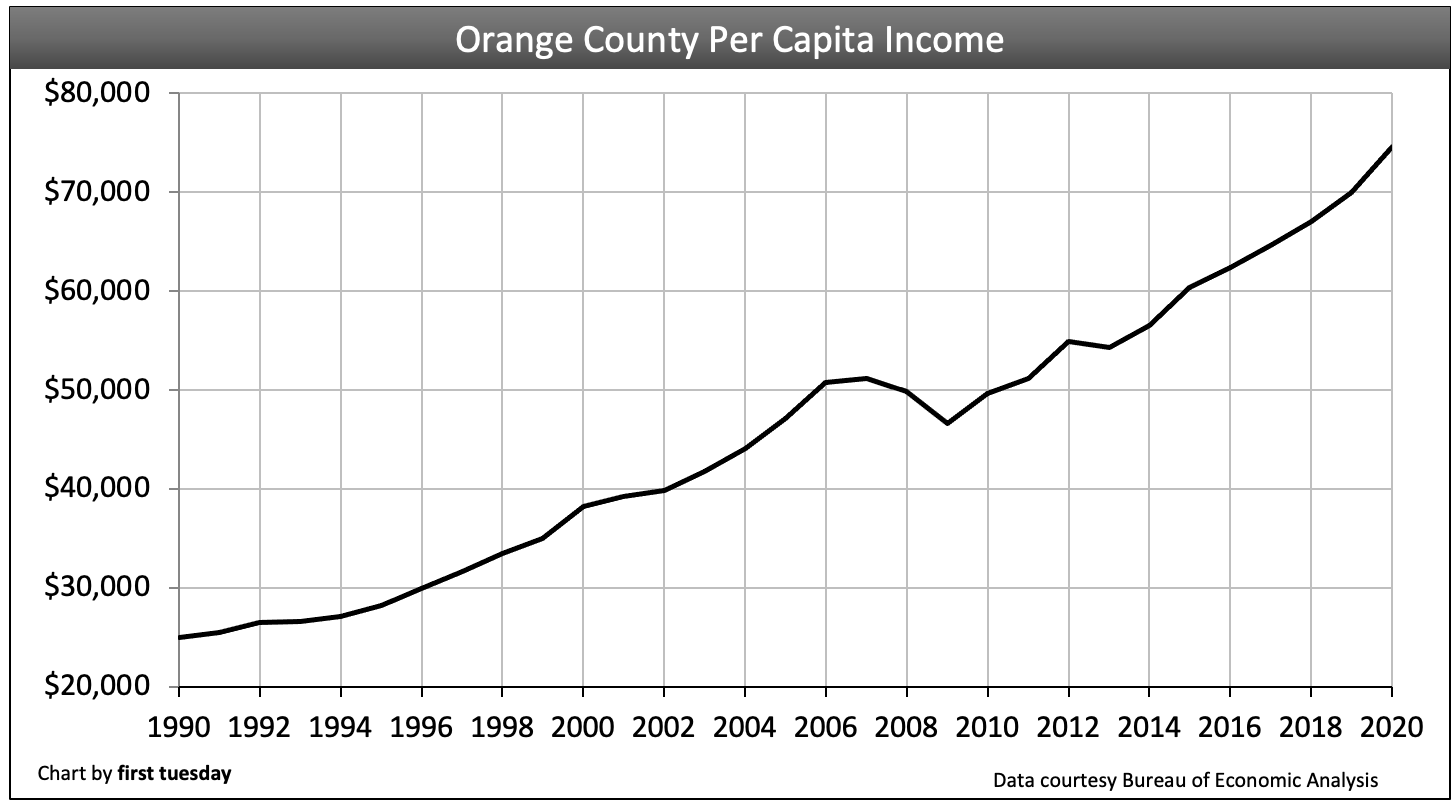
Chart update 05/09/22
| 2020 | 2019 | Annual change | |
| Orange County per capita income | $74,600 | $70,000 | +6.7% |
| California per capita income | $70,000 | $65,300 | +8.3% |
The average income earner in Orange County made $74,600 in 2020 (the most recently reported data from the Bureau of Economic Analysis).
Sustainable home price increases (not driven by cash-heavy investors or market momentum) are limited to a ceiling set by personal income, the annual rate of increase from 2019 to 2020 in this region being 6.7%. Buyer and tenants are only able to pay what their incomes allow them to. However, his annual income increase was given further fuel by record-low interest rates, which caused buyer purchasing power to jump in 2020-2021. Yet, as interest rates reverse course in 2022, buyer purchasing power is swiftly losing steam, relegating homebuyers to rely on income increases alone.
Home sales will soon stand on their own absent the government support of 2020-2021 received in the form of stimulus and artificially-low interest rates. Thus, going forward, price increases will remain minimal until an optimal employment level is attained.
Look to 2024-2025 for the next significant increase in home sales volume and prices. This period will be driven by the shifting demographic trends of retiring Baby Boomers and their Gen Y and Z counterparts who will become homebuyers en masse following the next recession.




















Great presentation, but how do the numbers play under our new Covid19 environment?
Curious if the slow down in China is factored into these numbers. There are huge swaths of Irvine that are nearly 100% Chinese nationals purchasing with cash. The slow down in China (along with the Russian sanctions), have already caused a huge price drop and slow down in NY City’s apartment sales. Not that I expect Irvine to suffer in the same way as NY City, but I would think it would shave a point or two off these projections. Irvine has been a huge factor in new and existing home sales for some time now. Any effect in that market would have an out sized effect on Orange County’s numbers overall.
Great charts and information.
We’ve had modest rises in home price appreciation so far. Jobs are strong, demand is strong. No crash coming as borrowers aren’t buying with fake income like back in 2007. It is verified.
Orange County market is going to see a big crash and minimum 30% drop in value in 2017. It will become a buyer’s market as it was in 2010. Builders are building and property owners are selling higher than the new homes sales! It is time for a big change.
Orange County will remain a heavily demanded destination for home buyers. There is not going to be any drop in prices or increases in inventory. Where else are Orange County residents going to move and have the same benefits, nowhere. Also, the boomers are retiring and are going to have the freedom to enjoy more fully all the amenities available to them this location offers. My tenants are asking for multi-year leases, the first time since the recovery and so far I am keeping them at 1 year only. My advice if you are in the market to purchase grab something and lock in the still historically low interest rates available now.
I hope it crashes and burns to the ground. After it does, im coming in strong and buying! Brun baby, burn!!!
Azar = wrong
$1,000,000 house in Orange County will drop to $700,000? Ok AZAR time to take your medication…
Turnover rates are likely to rise dramatically in the convergent 2019-2021 boomlet period raising rental vacancy rates. Then, members of Generation Y (Gen Y) will collectively first rush to buy but since their income and job security is considerably low they end up renting and housing market is going to crash sometimes between 2017-2020.
This author is using a lot of definitive verbiage on the future. As an example, “Sales volume will bottom again in 2017 before rising continuously into 2019-2020.” Shouldn’t the word “likely” be in there somewhere, since the author is making a prediction based upon a range of possible outcomes and the future is inherently uncertain?
Sam it’s. Common for analysts to use definitive language. It strengthens their prediction by showing they fully believe it and are not riding the fence by saying what it might do.
this article is post 2015…. yet above comments were make 2013?? there is research done by citi, regarding if central bank in china or Russia or Norway sell 2 trillion t bills that will make rate jump 4.4% adding current 3% to around 7.4%!!! if that happened imho…. we could c house prices 5 to 6 folds in a snap??? 2015-11
Good incos, Thank you.
Home prices aren’t limited because we have 30% cash buyers in the market with a low inventory hang over. The market is not the best indicator to correlation to DTI this time because to many cash buyers who don’t need income to buy and a major inventory crisis here
home price appreciation is limited to a ceiling set by personal income, the annual rate currently being 3.4%
Not correct. This is only one of many factors.
Housing Inventory Crisis is # 1 reason why home prices are rising. Prices are now rising faster than incomes and because CASH buyers are so prevalent it creates distortion in market prices. We will pay for this down the line. Mini Bubble 2.0 in full motion
http://loganmohtashami.com/2013/02/27/housing-inventory-hangover-will-continue-in-2013/